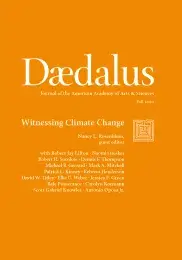Let Me Tell You a Story
I’ve spent my time caring for the Life-sources of Land, Air, and Waters–the LAW of Life. It began by being touched by the Sea and the story of my mariner grandfather. It went on to raids to fight environmental crime syndicates in the Philippines and on to the court of law. The Court is a good venue to light a STAR: to tell a Story, put the issues on the Table for orderly discussion, spark Action, and arrive at a Resolution. I founded the SEA Camp (Sea and Earth Advocates) to train children to care for the Sea and Earth and, later, founded the School of the SEA. Twice–in 2008 and in 2013–I saw the School erased by an extraordinary typhoon, a foretaste of the climate crisis. I’ve realized that when you use the law and science to change the mind, it can change tomorrow. But when you change the heart, it is forever. In the midst of the ongoing climate and COVID-19 crises, I believe that we can change the story of the world if we change the storyline. “The seeds of goodness live in the soil of appreciation for goodness.”
Do you know this good-looking gentleman? Is he a military man? An actor? You probably don’t. He was my grandfather. He was a merchant mariner, one of the first in my country, the Philippines. He was a rich man and I grew up with him. He treated me like a son.

At eighty, he passed on. A day after he was buried, his lawyer called me and requested that I visit his office. There he told me that my grandfather left me an inheritance of about $10 million.
What does a sophomore law student do with that kind of money? I deposited it in the bank. The day after, I withdrew $2 million. I took my friends out drinking, carousing, and gambling. In a few hours, $2 million was gone. The next day, and for three more days after that, I did the same thing: withdrew $2 million, went drinking, partying, and gambling. On the sixth day, I had only about $100,000 left.
What took my grandfather eighty years to save, I squandered in less than a week. As if that is not bad enough, I went to my accountant and instructed him to list all my expenses and losses as revenue and profit. I also told him I was making good progress in my quest for mature development.
Is that correct?
Are we not doing the same thing to the Earth? The Earth took 4.5 billion years to become what it is. It is the only planet known to contain Life and the sources of Life: the Land, Air, and Waters (LAW) of Life.1 The animal Homo sapiens, in its present shape and form, has been here only for the last one hundred thousand years or so, literally a blink of the eyes of Grandfather Time.
About two hundred years ago, the industrial revolution began the era of mindless consumption: We started to use Earth’s Life-sources faster than they could replenish. We cut down trees that took all of time to grow, sell them off as lumber, and count them as revenue. We scoop out the Seas to eat fish by the millions of tons, fish that were here long before us. In a matter of hours, we dig out carbon that formed over one hundred million years, and burn it as coal, oil, and gas. In a matter of minutes, we burn them to run our cars and light our homes, belching out poisonous gases into the very Air that we breathe. We take out so much from the Earth, use it for a while, and then throw it away as “waste.” We call it progress and development.
And we dare to call ourselves “wise.” Homo sapiens.
Oh, the story of my grandfather? It is only a story. The best stories are those that blend fact, fiction, and fantasy. The fact is that he was my grandfather. He was a merchant mariner and I grew up with him. The fiction is that he was very rich. The fantasy is that he left me a big inheritance that I squandered in a few days.
But, again, is this not the fantasy world we are living in? What took the Earth 4.5 billion years to form, we burn in a blink of an eye. And what remains we throw away as solid, liquid, and gaseous wastes. And then we call it a “contribution to GDP,” that modern measure of “economic progress.”
The textbook definition of the word economic is the “efficient use of scarce resources.” Is waste good economics? What is the meaning of GDP? Gross domestic product? Or great disaster for the planet?
Unguided missile. Shortly before I was born, my mother was diagnosed with throat cancer. I was hurriedly left in the care of my grandparents. My grandfather was a harbor pilot and merchant mariner, and my grandmother, a loving homemaker.
My adolescent years were unremarkable. My only achievement, if one can call it that, is that I was kicked out of two high schools. The last high school that accepted me put me on probation for two years. And during that time, the school gave me the lowest conduct grade ever given to any student in its entire history. It was not for any serious offenses (such as for fighting, drinking, or stealing). It was only for being generally restless, for mischief making, and for rabble rousing. This was before medical science discovered the meaning of attention-deficit/hyperactivity disorder (ADHD).
Luckily, I graduated high school on time. Not knowing what better to do, I took a course on business administration. After graduating, I worked for an investment bank as a “financial analyst.” In other words, I spent day after day counting other people’s money, and trying to figure out how to make them more money.
In the world of business, I saw how others advanced their careers with an MBA (master of business administration). So I took the qualifying exams to two U.S. business schools: Wharton and Harvard. I took the exams twice. I flunked twice. Thank you.
After one year as a junior financial analyst, I was promoted. On the same day I was promoted, I resigned and decided to be a . . .
Beach bum. My grandfather, who was my adoptive father, was from a small and remote island in the Central Philippines: Bantayan Island in the Province of Cebu. In his later years, he bought a coconut farm there that had a little opening to the beach: turquoise water, blue clouds, and palm trees shooting up from the white sand.
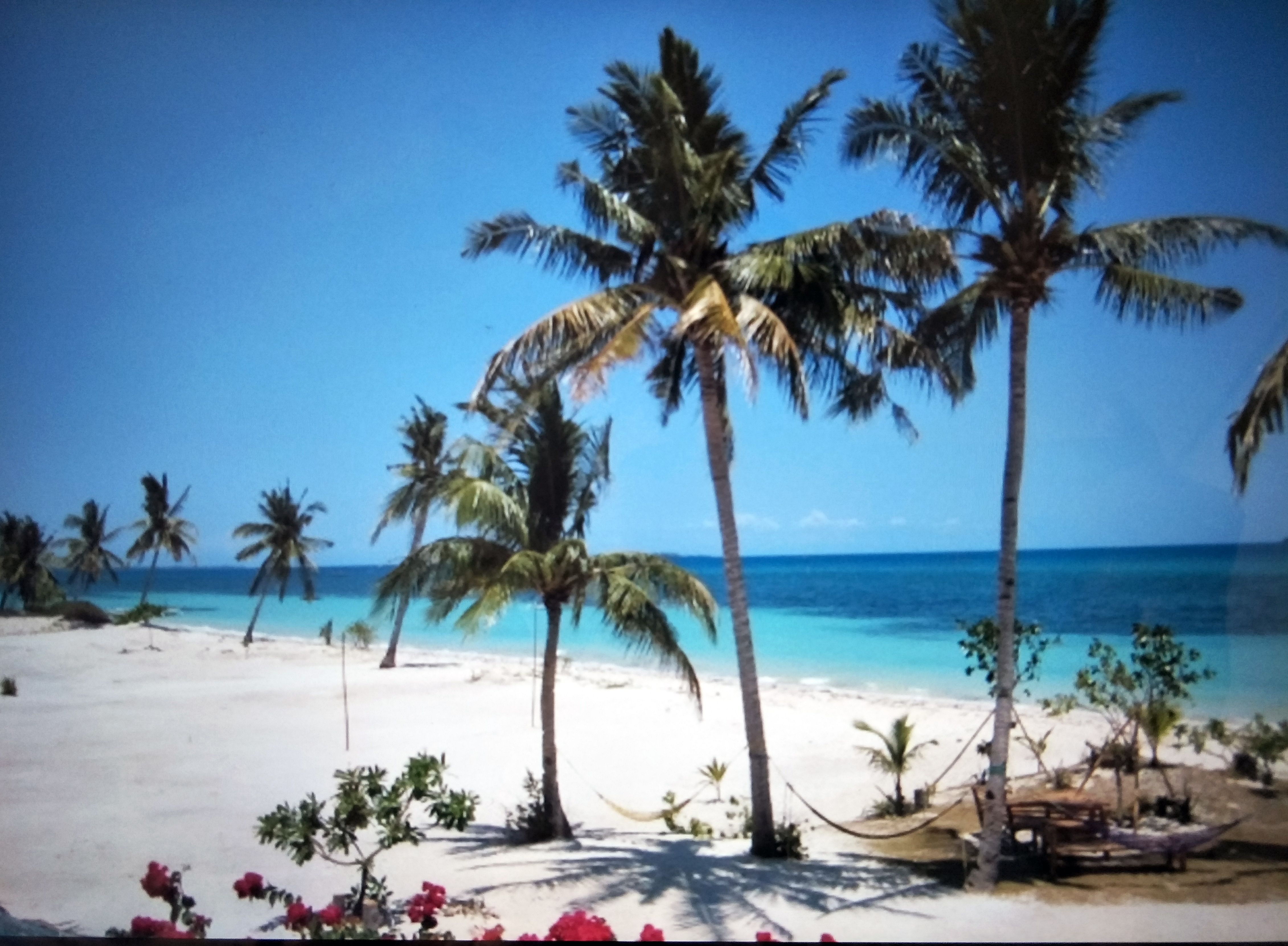
The seashore that began a Life’s SEA-change, Bantayan Island.
Holy Week in the Philippines is a four-day holiday affair: from Holy Thursday to Easter Sunday. During these holidays, my grandfather would take me to Bantayan Island. Even today it takes a full day of multimodal travel. Perhaps because it is far, the island is preserved a bit better than others.
On Good Friday in 1975, we went to Bantayan for our customary beach picnic. I was twenty years old and had just graduated from a prestigious business school in Manila. When there were not too many who could afford a car, I had a sports car. In my hometown in Cebu City, I was the prince of a ten-bedroom prewar house. I had servants, a car, and a chauffeur at my beck and call. When not many people could afford a plane ticket, I shuttled to Cebu and Manila every few weekends to visit my grandparents–and my girlfriends in both cities. A typical rich kid, an unguided missile.
Walking along the beach on this remote island that Good Friday, I saw the homes of the fishermen. They looked “poor.” A thought passed my mind: If a poor man becomes rich tomorrow, that is easy. But what if a rich man became poor tomorrow? I wonder.
In a moment of mere madness, I decided to try being poor. I decided to stay behind on the very remote beach that had no electricity, no running Water, not even a market. Except for a shack that served as our beach picnic area, there was nothing there. I stayed behind with one pair of pants, two shorts, a couple of T-shirts, a pair of flip-flops, and about 100 pesos (2 USD).
That was the beginning
Of this long walk to simple living.
A small step in a journey,
By the Sea.
Law school and an awakening. With a business management degree, a stint in the world of money, and after beach bumming for a year, I realized that I knew absolutely nothing. I hardly even knew how to read. I thought that maybe I should go back to school. Being a doctor (like my father), an engineer, or an architect was out of the question.
I learned how to seek the advice of the Sea. After dinner, I would go out to the beach, listen to the silence of the heart, and to the whisper of the waves. I was told by the Sea that I needed to learn how to read. And what could be better than the serious reading required by law school? So I applied to the country’s top law school at the University of the Philippines (UP). Not too many were interested in law then for the simple reason that it was the era of President Ferdinand Marcos’s one-man-rule under martial law. Very few applied, so I got lucky and made the cut. And thus began my journey of learning how to read.
I coasted along law school for two-and-a-half years. (A law degree in the Philippines takes four years.) For the first time, I was forced to sit down, read, and try to understand what I was reading. It was an insignificant time in my Life. Law school, and the way law is taught, is very boring.
Then, in the second half of my third year, I went home to Cebu for the Christmas holidays. I invited my best friend from the Island (Johnny) to join me. At about three o’clock in the morning of December 29, 1979, there was an accident. A big prewar house where I grew up, and which seemed indestructible, burned down in less than an hour. The fire took the Life of Johnny. Barely able to escape it myself, I went through suffering that you would not wish even on your worst enemy.
I went into a coma for forty days. By the sheer magic of modern medicine and the dedication of the men and women who cared for me, I woke up. The Spanish have a nice saying: mala yerba nunca muere (“bad grass never dies”). From my journey of learning to read began my journey in search of meaning.
Maybe it is true that what does not kill us will make us stronger. I began to appreciate the value of Life, and a search for something beyond my own. In law school, I asked now: what is the law?
Back to living life. After a year’s leave of absence, with a brain addled by anesthetics, sedatives, and painkillers, I went back to law school. Reading and remembering were not very difficult. They were impossible.
But somehow, despite being boring, law began to have some meaning. It is something that took me a lifetime to figure out.
In my last year of law school, my undiagnosed ADHD acted up again. I had to find things to do outside of the law’s hallowed halls. Between, and sometimes cutting, law classes, I went to take other classes in the other colleges. The teachers were kind enough to let me sit in on classes of literature and philosophy. Before my accident, I played the guitar quite well. With lost dexterity, I tried to find another musical instrument. So I thought, what is the best musical instrument? The Human voice? If so, can I try to train it in the UP Conservatory of Music? And in my last year, I organized the Forensic Society (public speaking) and made it to the editorial board of the Philippine Law Journal. My grades were not too bad. Grades are like money. If you do not chase them, they will find you.
But my best work in law school was in peacemaking. I invited representatives of the student government, law school groups, and (often-warring) fraternities to plant trees in front of the UP Law Center.
Today, decades later, those trees are standing there, alongside others planted by those who were inspired by our efforts. Today, in their own little way, they give shade and help clean the Air.
Managing to pass the bar exams, I became a lawyer. Now what?
I was offered jobs in prestigious Manila-based law firms. I thanked them for the honor, but respectfully declined. Instead, knowing nothing, I went back home to Cebu and began a law practice. I wanted this license in law to do something meaningful.
I gave my legal services, pro bono, to detainees who did not have a lawyer. I volunteered for the Legal Aid Committee of the Bar Association, and as the Court’s de officio counsel for the criminal cases: prosecution or defense, whoever cannot afford a lawyer.
That was good litigation training. My practical approach was to approximate human and divine justice. If a client was guilty, I did not try to acquit him. That would be an injustice to the offended party. Rather, I would only try to get my client the best plea bargain that the law can give. Whether I was for the prosecution or for the defense, I tried to be fair and square. With that as my guiding star, I achieved the purpose of approximating the idea of justice: to give and receive what is deserved. In two years of rough-and-tumble litigation, I did not lose a single case.
How did I survive financially? That was another little piece of magic. Having learned to live simply, I did not need much. I even took care of my grand (adoptive) mother. I built a small native-looking house made of wood, thatched roof, and bamboo on a small piece of land up a hill. It had a wonderful view of Cebu City, the Sea, all the way to the neighboring islands, and had enough space to take care of my long-time dream pet: a horse.
After these few years of hard-knuckles law practice, I was again bored and
decided to change paths. I applied to a top Manila-based law office and practiced commercial law for three years. Of course, I eventually found it boring, spirit-sapping, and devoid of meaning.
Whisper of the waves. On the beach of Bantayan Island, I asked the Sea again. What now?
On one hand, here I am, a lawyer. On the other, the only things I really cared about were the Sea, the trees, and the fish.
The waves did not whisper an answer. I only heard their sound and saw the sparkling stars of the evening skies. With the guidance of two of my former law professors, I discovered that there was such an animal called environmental law. What is that? What is this creature called the “environment”? In 1988, I traveled to the University of Oslo to take a short course on energy and environment. After that, I published my first article on climate change and soft energy paths, in a leading national newspaper.2 Of course, nobody read it, not even me.
Taking another leap of folly, I began to focus my practice on the then-unknown field of environmental law, mainly pro bono. I thought that maybe I could use the law to protect the Sea, the trees, and the fish, even if they cannot pay my attorney’s fees.
To pursue this creature, I uprooted my family from Cebu and moved to mad Manila. It was during this time that I discovered the serious condition of the country’s old-growth forests. From about fifteen million hectares forty years before, only eight hundred thousand hectares remained. More amazing was that despite this fact, during Marcos’s martial law era, from 1972 to 1986, the government granted logging concessions to an area covering about four million hectares. Do the math: the government granted five times more old-growth forestland for logging than was available. And these forests were being cut down at the rate of one hundred and twenty thousand hectares per year.
One does not need rocket science to figure out that the numbers don’t add up. To my simple mind, it was simply this: when my children grow up–the eldest of whom was then three years old–they would never see a Philippine forest.
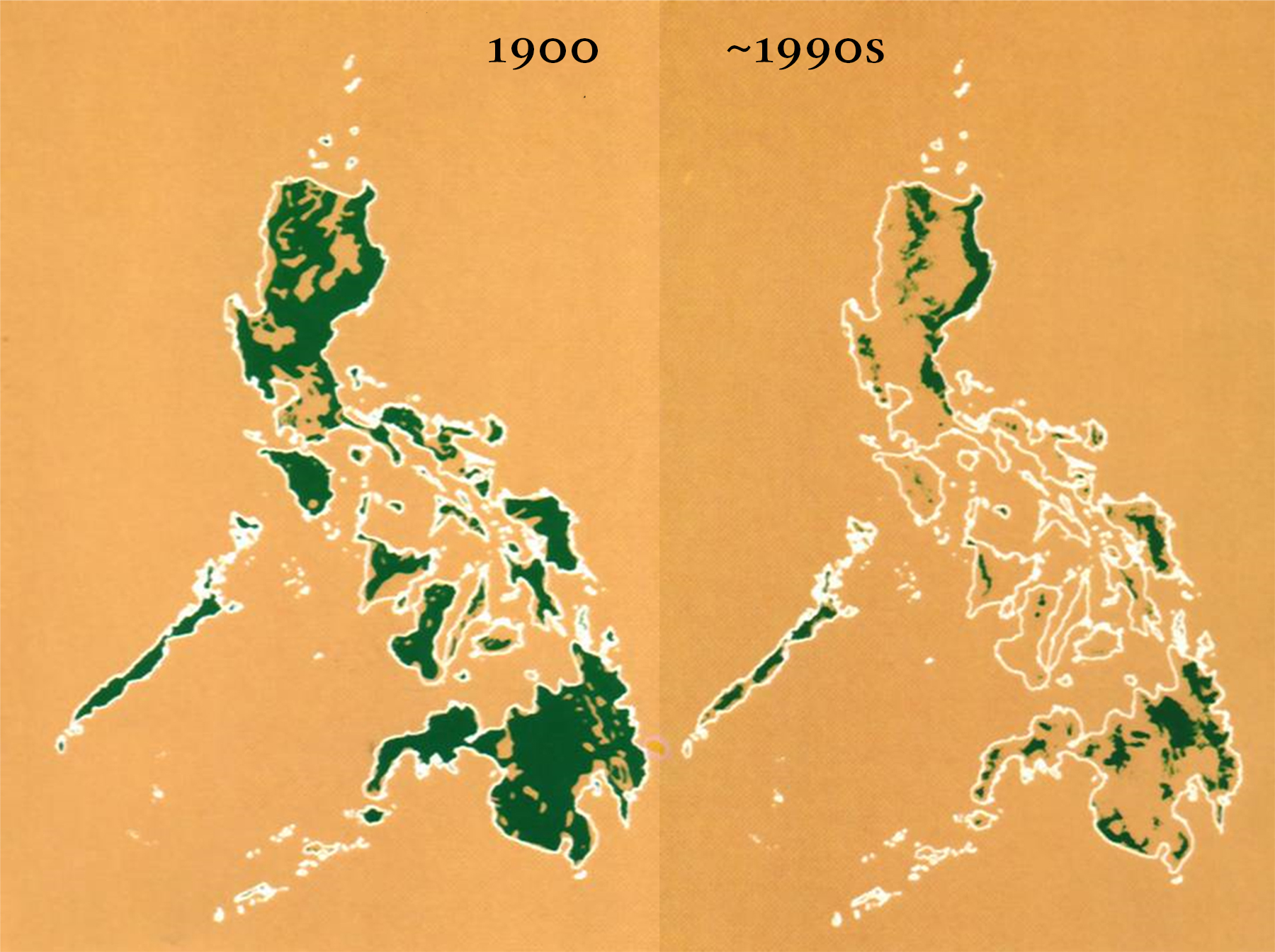
By 1988, only eight hundred thousand hectares of the Philippines’ old-growth forests remained (green areas on the maps). The government had given rights to commercial loggers to finish the job. Image courtesy of Peter Walpole and the Environmental Science for Social Change, Ateneo de Manila University.
If I went to the media and attended hearings in Congress, who would listen to a young lawyer who represented trees? Even if they did listen, I might get ten seconds of their attention.
But in a court of law, the story can be told better and the issues discussed more extensively. The points to ponder are placed on the table for proper discussion and backed by evidence. And then, who knows? Maybe it will spark some action. In the end, one way or the other, win or lose, sooner or later, there will be a resolution.
With my children and the children of my friends and relatives acting as plaintiffs, representing their generation and generations yet unborn, I set out to tell a simple story in a court of law. We petitioned the Department of Environment and Natural Resources (DENR) to stop issuing timber licenses. The Philippine Constitution lays out the duty of the state to “protect and advance the right to a balanced and healthful ecology in accord with the rhythm and harmony of nature.” We argued that this responsibility includes, among many roles, managing and preserving the country’s forests. Dismissed in regional court, we brought the story to the Supreme Court.
The case found a willing and understanding defendant in the Secretary of the Environment and Natural Resources Fulgencio “Jun” Factoran Jr. To his eternal credit, Factoran used the case to do the right thing. In 1991, while the case was pending, he issued a brilliant departmental order that stopped all logging in the remaining eight hundred thousand hectares of old-growth forests. One year later, in 1992, President Corazon Aquino signed into law the National Integrated Protected Areas System (NIPAS) Act. It named the remaining old-growth forests as the initial component of the country’s protected areas. Yes, the stars aligned.3
So, the policy matter–the ban on the remaining old-growth forests–was happily resolved by the executive. But a point of principle was not resolved by the trial court. The case was dismissed in regional trial court because the children, representing themselves and future generations, did not have a cause of action. That was a major setback in my effort to tell a story, and it posed a major dilemma. Here I was, a young and jobless lawyer. What can I do? What must I do? The better option is to let it go and move on to earn a living for my young family.
But being a hard-headed SOB (son of the beach), I decided to bring the matter to the highest court. Win or lose, who cares? I had nothing more to lose anyway, since I already lost in the trial court. All I had to spend was time, effort, and some money for photocopying, filing fees, mailing, transportation, and so on: quite a lot of money that I did not have. All I really wanted was to tell a story, to make a point of principle, a basic truth: that with what we were doing to the forests, the children and future generations have a right to speak, to take action, and to be heard in a court of law. Hard-headed SOB asking for the ridiculous.
The stars again aligned. After the case was lost in trial court and when I decided to take it to the Supreme Court, I discovered another wonderful creature that gave a sophisticated name to what I was trying to do. Through Dinah Bear, then general counsel of the U.S. President’s Council for Environmental Quality and Chair of the American Bar Association Committee on Environmental Law, I discovered the work of someone by the name of Edith Brown Weiss of Georgetown Law. A couple of years before I filed the case in 1990, she had already written an entire book entitled In Fairness to Future Generations. In that book, she coined the terms intergenerational justice and intergenerational responsibility. Wow. Big words. But it was the theory that legitimized my simple idea of our duty to our children and to future generations. Now I could present this book to the Supreme Court. Maybe they will see that this idea is not so ridiculous after all, and that I am not as dumb as I look.
The stars aligned once more in the Supreme Court. The case landed on the desk of newly appointed Justice Hilario Davide Jr., a true son of the Soil. In his hands, the legal action was transformed into a wonderful narration: a story that trembles on the brink of poetry. On the question of whether the children and future generations had the right to take this legal action, the Supreme Court said,
These rights need not even be written in the Constitution for they are assumed to exist from the inception of humankind. If they are now specially mentioned, it is because . . . unless it is written in the Constitution itself, the day would not be too far when all else would be lost, not only for this generation but also for succeeding generations, generations which stand to inherit nothing but a parched earth incapable of sustaining life.4
The passion for the trees and forests led me to bare-knuckle fights to stop commercial illegal logging. I began to explore the uncharted techniques and tactics of effective environmental law enforcement. The lesson I learned was that “The best form of law enforcement happens when the law does not need to be enforced. . . . If the law must be enforced, and a penalty is handed down, it must be done in a manner that is swift, painful, and public.”5
It also led me to begin exploring the idea of legal marketing: the art and science of selling the social good behind the law, the reason for the law, the ratio legis. Ordinary marketing sells a product. Law sells a mode of conduct.
In 1992, a wonderful man was appointed secretary of the DENR, Angel Alcala, a marine biologist and man of the Sea. We worked together to address the illegal commercial logging in the country, an industry with powerful backers, many of whom were in positions of great power. With a new law and a new president in 1992, there was hope in the Air. I declined Secretary Alcala’s offer to join government service as undersecretary for legal affairs. But working with the same love for nature, he took my humble advice to heart. Together we did amazing things to break the neck of illegal commercial logging. For the first time ever, there was waged a Land, Air, and Sea enforcement operation against illegal logging: the Oplan (Operations Plan) Jericho.
We created a special strike force to hit at the nerve centers of the illegal logging industry. We mobilized dedicated men from the Special Forces of the Army, Air Force, Navy, the National Bureau of Investigation (NBI), and the Department of Justice. But just when it was beginning to break the neck of the illegal commercial logging, Secretary Alcala was replaced.
With this, I learned a lasting lesson: government is a most fickle and unreliable partner. Sure, with the right people at the helm, it can do so much good during their time in office. But when the next person takes over, they will try to reinvent the wheel altogether. That is mainly the challenge for good governance: the lack of continuity.
Frustrated, I went on an extended holiday in Boston.
A year later, I returned to the Philippines with a fancy degree from a fancy law school. But instead of building on these credentials and making big bucks in the practice of law, on September 8, 1998, I made another mad, but maybe momentous, decision. I wrote a letter to all my paying clients to thank them for their confidence and to advise them that I was moving on. In one fell swoop, I gave up my revenue-generating law practice. I moved my office from the heart of the business district to a small and nondescript office not too far from my home, thus saving time from the long commute. I decided to focus my time on writing two books: A Legal Arsenal for the Philippine Environment and a storybook entitled The Laws of Nature and Other Stories.6
Four months later, jobless, penniless, and almost hopeless, I filed another crazy case. This time it was against a dozen government agencies to compel them to clean Manila Bay.
Center of the center of marine biodiversity. The Waters surrounding the central Philippine islands from Manila Bay in the north to northern Mindanao in the south (dark gray on the map) are known as the “center of the center of marine biodiversity on Earth.” This was an early finding of the world-renowned marine biologist Kent Carpenter.

The Manila Bay is a body of Water that lies in the apex of this area. In 1998, I stumbled on government records that Metro Manila alone was dumping sixteen million liters of raw sewage into Manila Bay, every single day. Maybe, it was time to tell another story.
This storytelling exercise was quite expensive, in time, effort, and money. It took all of ten years of litigation from trial court, to the Court of Appeals, all the way to the Supreme Court. Ten years, and all I got was a piece of paper that said the government must do what it should have done thirty years ago.
Has Manila Bay become cleaner since? In 2018, the scientific data showed that it got worse–one hundred times over. To the credit of the people in present positions of power (President Rodrigo Duterte, Secretary of Environment and Natural Resources Roy Cimatu, and Secretary of the Interior and Local Government Eduardo Año), there is now a serious effort to clean Manila Bay. Bravo! May your tribe increase, and may your efforts continue.
I fought many other cases in the courts of law. Often, I lost, sometimes I won–a paper victory. But through it all, I learned three important lessons:
1. It is all about telling a story. And I am only a storyteller, with words as my paint brushes, law as the medium, and the courtroom as the canvass on which to paint the story.
2. Win or lose, sooner or later, the end goal does not matter much. The only thing that matters is the joy of the journey.
3. In triumph and in disaster, only one thing will matter: laughter.
Wounds of war and bruises of battle. I fought other battles in court, on Land, and at Sea. I engaged in mano a mano combat to stop illegal logging in Oplan Jericho. In one case, I lost our star witness, Leonardo Tindoc. A dedicated government forester, he was murdered in front of his home.
At about the time I sued to clean Manila Bay, I began another adventure to care for the Sea. From cases in court to direct action seaborne operations, I tried to do it all. I organized another multisectoral, citizen-led legal strike force against environmental crime syndicates behind the illegal fishing business. Small blast fishermen in the open Sea detonate explosives in the Water to kill large amounts of fish indiscriminately, often destroying surrounding ecosystems like coral reefs. Instead of running after the small fry, we went for the “big fish.” With our team of dedicated citizens and NBI special agents, we went after the syndicates making and selling blasting caps and explosive powder. I’ve shared a short film clip of the strike force’s operations.7 It shows two of our many bold raids to arrest members of the blast fishing syndicates and to jail rich owners of commercial fishing boats that illegally intrude into municipal Waters reserved for small subsistence fishermen.
I stepped on many powerful toes and earned death threats in the process. On April 10, 2006, a news article in a local paper reported that there was a bounty of 1 million pesos for anyone who could kill me and my buddy and fellow guardian of the Sea, Jojo de la Victoria. Jojo and I laughed at it. We even joked that if the killers wanted, they could give the 1 million pesos to our families and we would take care of it ourselves.
Forty-eight hours later, in the afternoon of April 12, 2006, an active duty policeman, acting as a hit man, went to Jojo’s house south of Cebu City. As he was about to enter his home, Jojo was shot six times with a .45 caliber handgun, in front of his son.
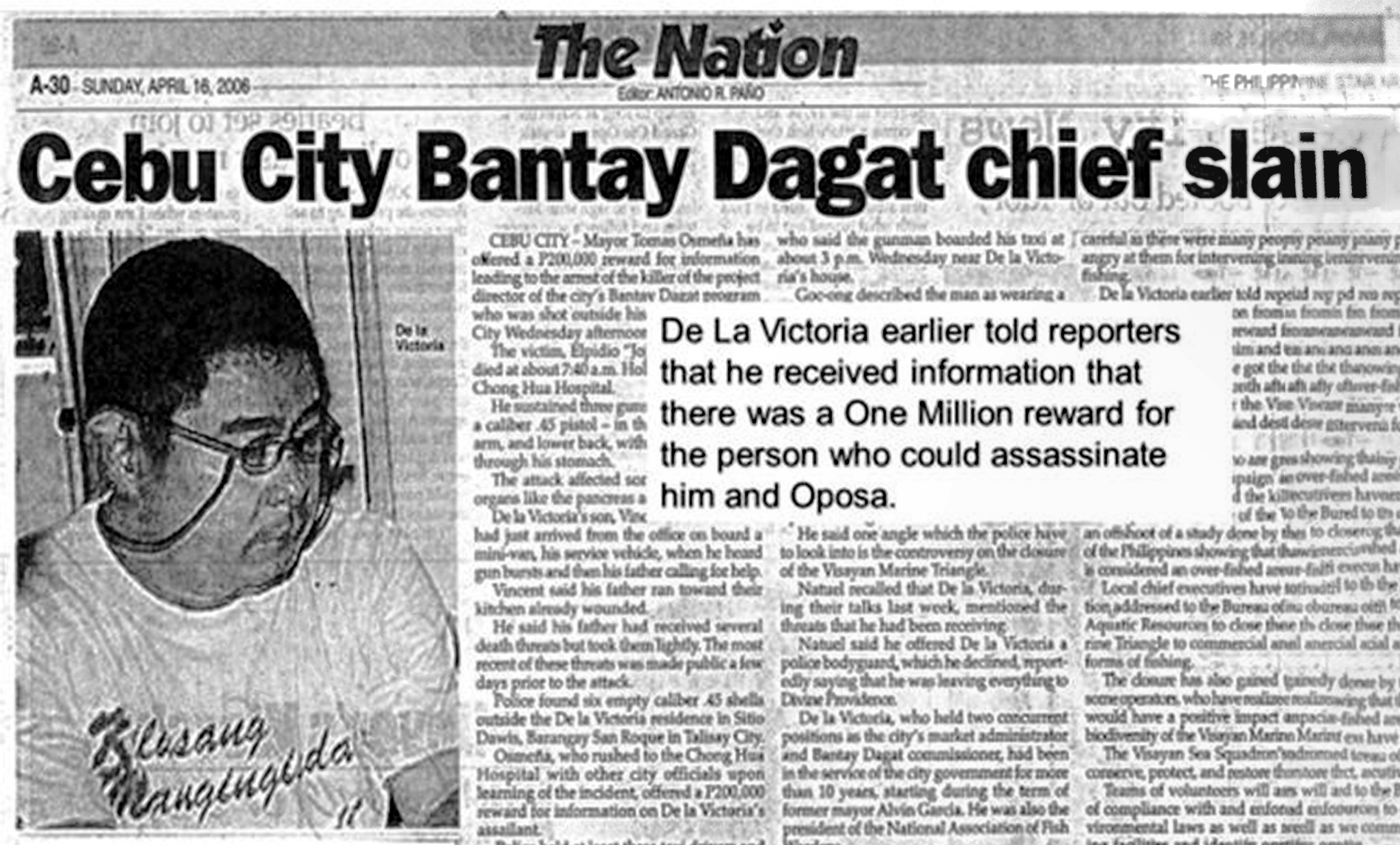
Guardian of the Sea and my buddy Jojo de la Victoria was murdered in his home in front of his son.
For once, tears flowed from my broken heart. Broken, but unbeaten. Jojo’s death only fueled the fire of my passion and that of my team. Three weeks after we buried Jojo, we raided another island notorious for being the hotbed of illegal fishing. Our efforts were the subject of a documentary film entitled Blast by the British Broadcasting Corporation (BBC).
What is even more surprising is that I was doing all this without any funding, and while being generally jobless. Where did I get all the money to do that? Frankly, I don’t know. I never think about money. I only think about what I want to do, and money (I call it Water) looks for me.
Did we wipe out illegal fishing? No. If at all, we only prevented it from getting worse. At least in my area of the Visayan Sea, we put a little brake on blast fishing. But illegal commercial fishing persists today.
A touch of kindness. With the threat upon my Life and my family, a friend from the United States showed a great gesture of kindness. He cashed in some of his savings to send me a check. He knew I was sailing in very stormy Seas. And he cared enough to give me the paddle to row and ride out the storm.
More than the amount, the gesture of kindness and of caring and sharing touched my heart beyond words. Instead of using it for myself to hide and to keep my family safe, I decided to make the gift go farther. I used it as the seed fund for a greater good. To honor my fallen friend Jojo, I founded the School of the SEA (Sea and Earth Advocates) in the beach place I had on Bantayan Island. I envisioned it to be a training center for people who dare to care for the Sea and the Earth. A wonderful dream. So I put up a wonderful structure made of native materials (bamboo, palm leaves, and coconut lumber). Its light materials were very appropriate to the island’s tropical climate conditions. It was an architectural piece of art. In May 2007, we held a fun opening of the School of the SEA.
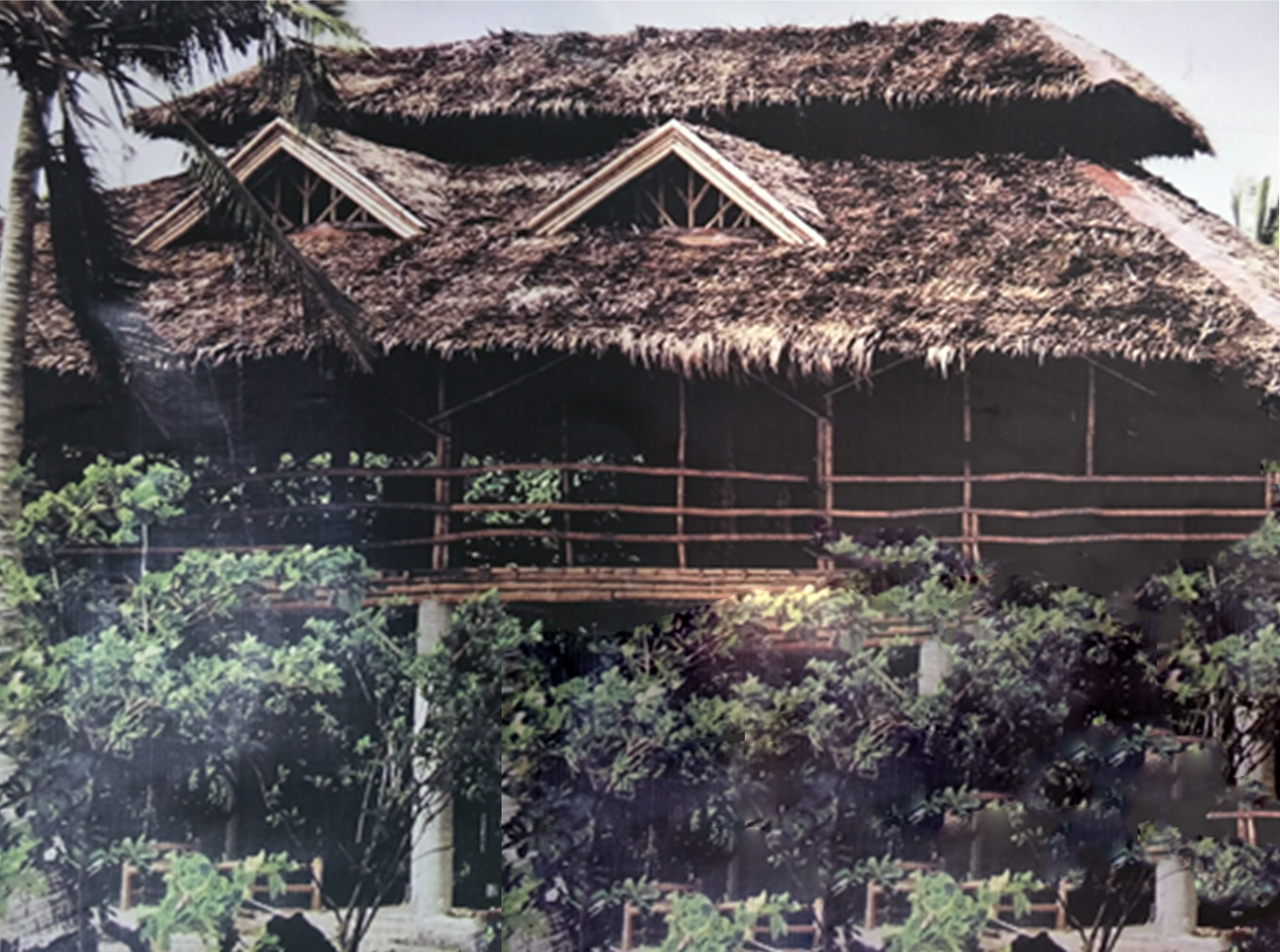
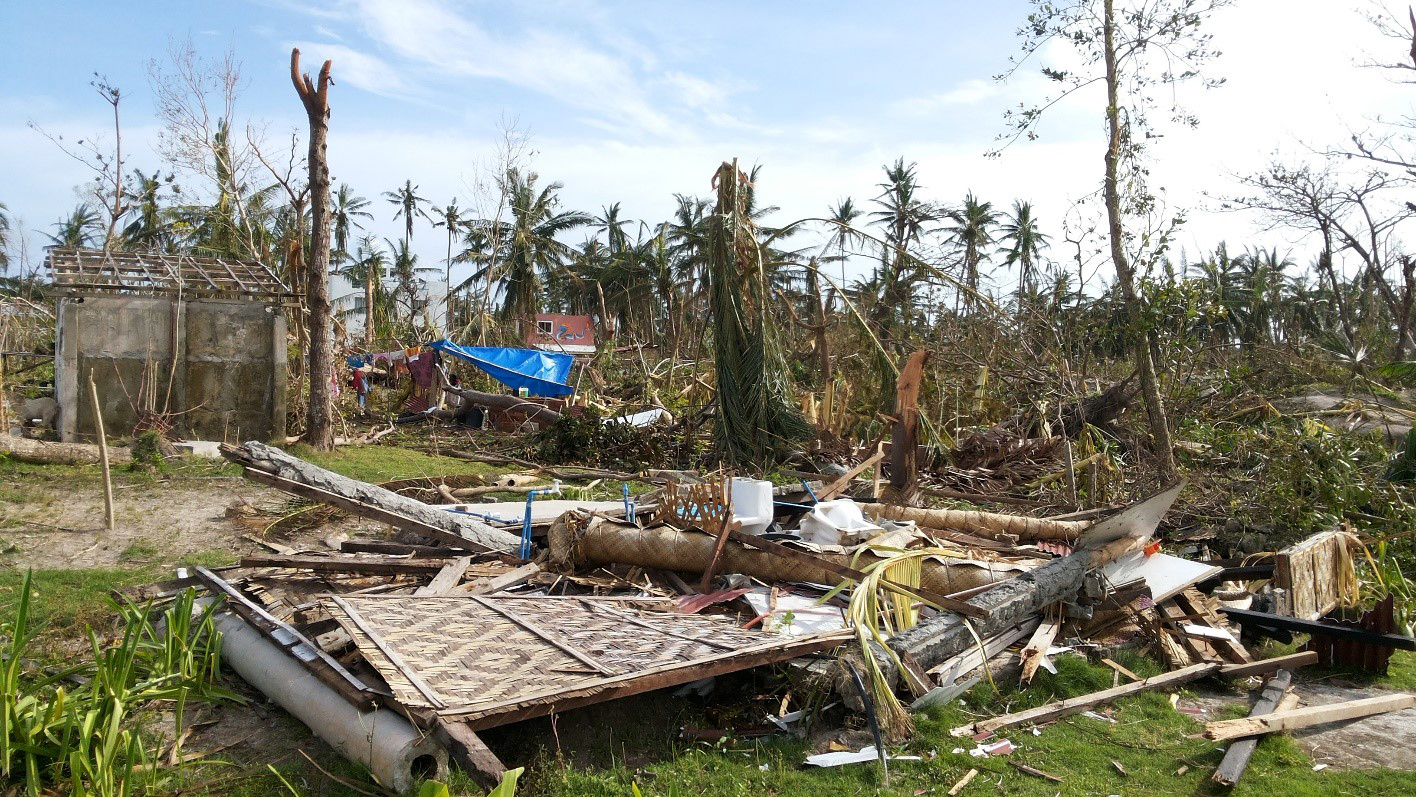
The School of the SEA before (above) and after (below) Typhoon Frank.
One year later, in 2008, an extreme weather event happened. Typhoon Frank poured extraordinarily heavy rain on Bantayan Island. Every structure on the island made of native materials collapsed under the weight of the heavy rainwater. Rain that should have fallen in weeks poured in one day. The entire School of the SEA, barely a year old, collapsed. Boom! There goes my dream school. It was my first taste of an extreme weather event. Maybe, the climate is in crisis.
But that seed planted by a gift of kindness has since grown into a bigger dream. After a short effort to be a School of the SEA, we went back to being the SEA Camp. But now, it bears a more descriptive meaning: Sea and Earth Advocates of Culture, Arts, and Music for the Planet. You can see the short film of our April 2018 re-inauguration.8
Thank you ever so much for that seed of kindness to the mentor of mentors, the guru of gurus, and a guiding light in the stormy Sea of Life: environmental law scholar with a giant heart, Nicholas A. Robinson.
Climate of change. When I wrote the article on climate change and soft energy in 1989, climate change was only a scientific theory. Although there was growing evidence that it was happening, no one really understood it.
I pretty much forgot about climate change for the next twenty years. I spent those years trying to use the law to fight the abuse against the forest and the Seas. Using the law to care for the Land, Air, and Waters of Life.
In 2007, I was invited to attend a conference on climate change at the National University of Singapore with my esteemed friends and environmental law scholars Koh Kheng Lian and Lye Lin Heng. Nick Robinson also attended.
To give context for the Singapore meeting, I measured the front yard of the beach house that I built in 1994. While the law only required an easement zone of twenty meters from the high-water mark, I made my house forty-five meters away from the Sea.
In 2007, merely a decade later, the distance from the house to the Sea had shrunk to only twenty-five meters. Scientific evidence showed that there has been only a two-inch rise of the Sea level. When I saw that, I realized that Sea level rise is most probably real.
What if the Sea level rises to six inches? Or twelve inches, or twenty-four inches, or more?
Montreal Protocol. In the year 2007, my longtime buddy and international environmental lawyer par excellence Durwood Zaelke invited me to join him on the journey of taking on climate change. He asked me to help represent the Federated States of Micronesia (FSM), a country of many islands floating somewhere west of the Pacific Ocean. We had something in common: the Sea was eating up our island homes.
Here is the greatest challenge in the science of climate change: The steps between the causes and effects are too many and too difficult to connect for the ordinary mind. We can take only one or two thinking steps at a time. Unlike Air and Water pollution, deforestation, and other clearer environmental issues, the effects of climate change cannot be seen right away. Why is the climate emergency so difficult to understand?
Things that today make our lives comfortable,
Will tomorrow make our lives miserable
Try explaining climate change to ordinary people. Try making them understand how climate change is caused by the electricity that lightbulbs use to make their evenings bright. Try explaining how the motor vehicles that bring them where they want to go, the air conditioners that cool hot days, and the heaters that warm the cold are all related to the climate crisis. Try explaining how the cows that give them the meat that they eat, the methane from the rice that is a staple of so many people, and all the conveniences and comforts of modern Life are the very causes of this climate crisis. Good luck. I am confident that you will only see eyes grow bigger in disbelief.
In 1974, researchers at the University of California, Irvine, reported their discovery that certain man-made chemicals, the tongue-twisting chlorofluorocarbons (CFCs), damaged the umbrella of the Earth: the ozone layer.9 After some convincing, the world responded in 1985 with the Vienna Convention for the Protection of the Ozone Layer. This would be the framework for the Montreal Protocol on Substances that Deplete the Ozone Layer (MP), signed in 1987 and put into effect in 1989. The MP is the international environmental agreement that phased out ozone-depleting gases.
The Montreal Protocol is known as the most successful international environmental law. In thirty years, it has significantly reduced the use of ozone-depleting CFC gases. It is a remarkable achievement. But, before we pop open the bottle of champagne, consider this: The gases used to replace CFCs were effective, but they had a terrible side effect. They are thousands of times hotter than carbon dioxide. They are called hydrofluorocarbons (HFCs).
Environmental litigator Durwood Zaelke and his small but savvy team of scientists, lawyers, and public citizens worked behind the scenes to push for the reduced use of HFCs.
It was a very long and tedious journey to take on. I saw first-hand how slow, tortuously painful, carbon-costly, and time-consuming is the world of international environmental politics and diplomacy. It took all of seven years for the state parties to agree to reduce the use of HFCs in the landmark Kigali Amendment to the Montreal Protocol in 2016.10 Implementation of the agreement will take many more years.
Though by the standards of international environmental politics, the Montreal Protocol came together very fast. Consider the long path of the Climate Convention. In 1992, the UN Framework Convention on Climate Change was passed in Rio de Janeiro. In 2015, we got the Paris Agreement. After almost twenty-five years, all the state parties did was to agree that the problem is real and that it needs to be solved.
Remember what we said about how fickle governments are? In 2016, a new president took over leadership of the country that is the biggest source of climate-heating gases. All by himself, he withdrew from the Paris Agreement. Poof!
International environmental politics is grounded on a country’s self-interest, mainly economic interests. What I have seen is that to prepare for the climate emergency, international politics is not the best arena for rapid response and effective action. We probably need an immediate emergency of global proportions to reduce the use of oil and other climate-heating sources. Recently, the Philippines faced one such real, clear, present, and immediate emergency.
After the School of the SEA collapsed from the rains of Typhoon Frank in 2008, I started slowly rebuilding. Rising from the ruins, with my own meager means, we tried to train more students, teachers, and citizens.
Then came November 8, 2013. Then came Typhoon Haiyan (local name Yolanda), the most powerful typhoon to ever hit landfall. It breezed through the Visayan Region of the Central Philippines, and dropped by Bantayan Island and the School of the SEA. All our ten structures–mostly made of native materials–must have been so architecturally sound that we were not damaged by Typhoon Yolanda.
We were erased.
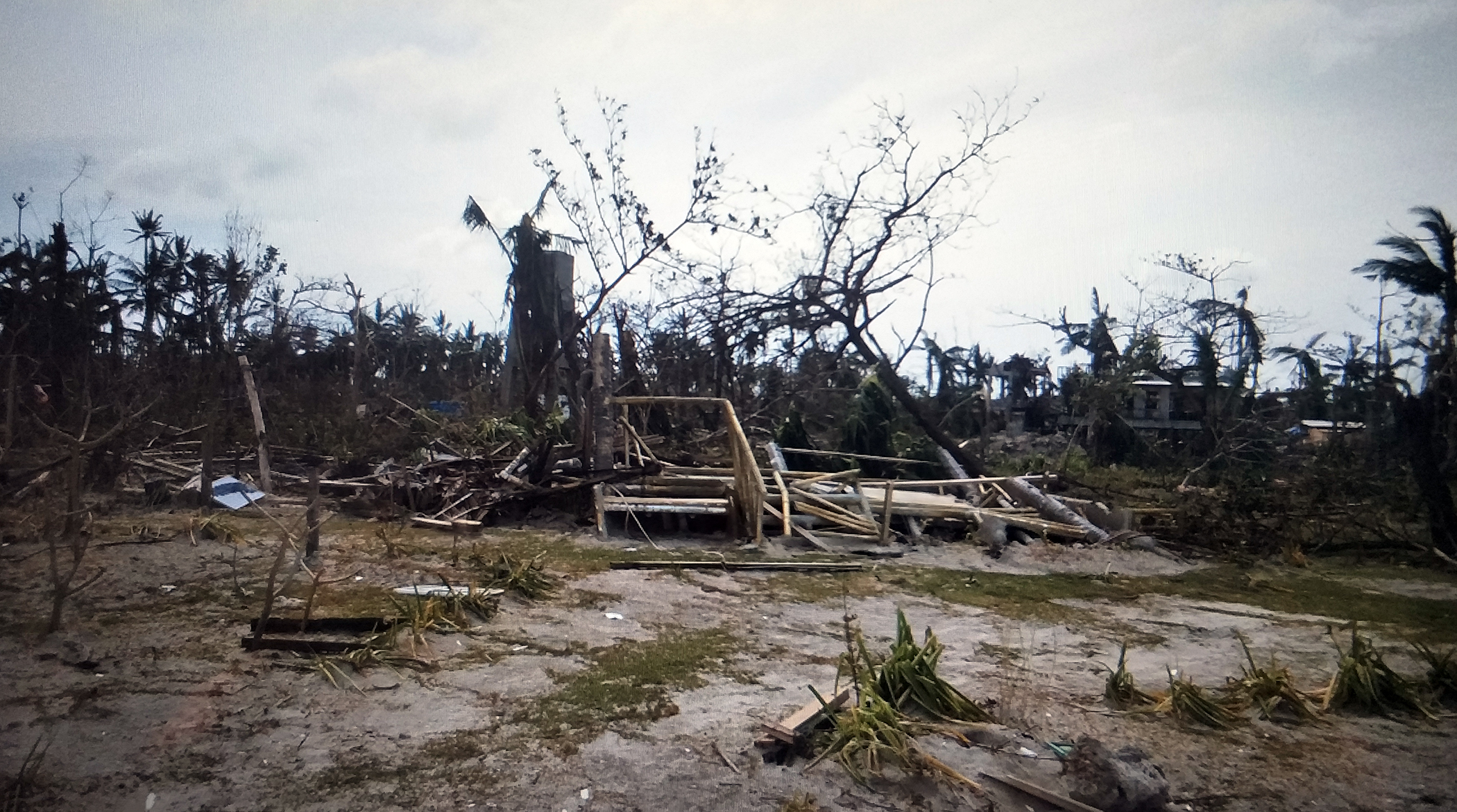
The resulting damage to us was mind-blowing and game-changing. The utter destruction, Water shortage, extreme heat and mosquitoes, and the general sense of hopelessness and helplessness must be a foretaste of things to come.
If climate change is real, the world must know about it, must try to do something about it, and must be prepared to face it.
It is time to tell another story.
Though nothing can bring back the hour
Of splendor in the grass, of glory in the flower;
We will grieve not, rather find
Strength in what remains behind.
—William Wordsworth, Ode: Intimations of Immortality
Legal mischief. How can we tell a story to the world? If we wrote a book, who would read it? How can we tell the story that the symptoms of this deadly virus called climate change are real, clear, present, and immediate? How can we present proof that the fires in Australia, the Amazon, and California in 2019, the heat waves, the strange weather, the Water shortages, the rapidly melting ice of the Arctic and Antarctic, the rising Sea levels, the ocean acidification are only the beginning?
At the end of 2019, another deadly virus appeared and forced the Homo virus to stop and do nothing. The huge silence it introduced gave us space to begin to understand ourselves. If only for that, thank you, COVID-19. For a moment, the world is staying at home, the roads are empty, the skies are clear, the Waters are clean, and the planes are grounded. If we do not learn from this experience, perhaps we will kill off the species that is causing all the problems of the world. But if we do learn, then that is when everything will come to Life.
If we were not so single-minded
To keep our lives moving
And for once, do nothing.
Then huge silence and interrupt this sadness
Of never understanding ourselves.
And then the Earth can teach us,
That when everything seems dead.
That is when everything comes to life.
—Pablo Neruda, Keeping Still11
Back in 1996, while learning how to sail on the Charles River in Boston (and pretending to earn a master of laws nearby), I wrote a paper for a course on international environmental negotiation. Instead of writing on the topics assigned, I decided to write about something else. I asked myself the question: how can we use law to spark awareness and action to face a global environmental issue? Since it was a class on negotiation, and not on litigation, I got my lowest grade. That is very OK. After all, I was not there for a master of laws (LLM); I was there to start my LMM: legal mischief making.
The idea of legal mischief making lingered on. After the 2008 collapse of the School of the SEA due to an extraordinary typhoon, I started taking action. In January 2009, kindred spirits and I came together to plant the seed of a global legal action on climate change. The plan was to prepare a template of letters and petitions, well-grounded on law and science, to send to government officials and urge action. The letters would also offer the government the support of citizens for strong, serious, and sustained action to face, and embrace, the climate
crisis.
That same year, there was an awards ceremony for the Asian version of the Nobel Peace Prize: the Ramon Magsaysay Award. The selection committee must have committed a serious typographical error because they gave it to a CBB: certified beach bum.
Instead of just talking Air at the awards ceremony, we launched the 10 Million Movement (10MM). The idea was that all change must begin within. We aspired to get at least ten million personal commitments to change the wasteful ways of this human virus. These are simple things like turning off lights and gadgets when not in use, not wasting Water, and carpooling. In other words, the idea is to be “the change that we want to see.”
Of course, the goal of ten million pledges for personal change was ambitious, audacious, and almost ridiculous.
With the help of a friend who had more tech skills than I, we launched the movement. I was excited, but realistically, if we got even one hundred personal pledges for change, that would have been worth it.
Fourteen days after the launch, I was told that the website had collected quite a few more pledges than that. In two weeks, we had twelve million pledges of personal change. This was 2009, before social media. If it could be done then, can we do it now? Can we change faster, better, and longer?
I Am Climate Justice. The idea of using law to spark action is unfolding as the I Am Climate Justice (ICJ) Movement.
I Am Climate Justice. What? Does that make us Marvel superheroes? A member of the Avengers? No, it only means that in each one of our fingers lies the power to give the present and future generations the Earth they deserve. That is what justice is: giving people what they deserve. If we do not waste Water today, we will have Water to drink tomorrow. If we turn off lights and gadgets when not in use, we save a lot of energy; then electric power companies will burn less coal, oil, and gas. Demand-side management, which a long time ago in my conversations with the Sea in Bantayan Island, I called the “need contraction theory.” Reduce your “needs,” and you will never want for what you really need.
So long as we continue to use cars and burn gasoline, people will produce them to make money. Note that cars have a very high carbon cost. It ranges from the mining of ore to make steel, the scraping of mountains for the rocks to build roads, the cutting down of native forests to plant rubber trees for tires, mining and refining oil to make and burn gasoline and diesel in the infernal combustion engines. We pave living Land with dead concrete to make the roads. We burn so much of what took hundreds of millions of years just to move ourselves from one point to another. So long as we continue to waste electricity in our homes and buildings, such as those big buildings in New York and other major cities where lights are on twenty-four seven, people will always burn more coal to produce electricity. To paraphrase an Asian wise man, Gandhi: There is enough for every one to use. But there will never be enough for any one to waste.
It is much like the demand for illicit drugs in America. The United States spends billions of dollars to fight the drug lords in Mexico and Colombia and their U.S. distributors. But so long as the demand for coke is there, the supply will always find a way to its customers.
Cut the demand, the supply will shrink. The ongoing COVID-19 crisis is a perfect example of reduced demand. For once, the price of oil tanked into the negative, as oil producers paid to store the barrels of oil that consumers did not need.
So what does the ICJ have to do with this?
Again, I Am Climate Justice is a movement to be the change that we want to see. It is a movement mainly of young people who are very concerned about their future. It has two levels: the local and the international. At the local level, it has two dimensions:
- Individual. For change to happen, it must begin within. People who wish to join the movement must pledge to be the change. They must shun waste: of Water, electricity, fuel, plastics, and so on.
- Collective. People who wish to join the movement have three game-changing interventions that they can accomplish by cooperation:
a. Food gardens. Members of the movement can plant and grow vegetables in their own homes and along public spaces. By doing this, they will reconnect to the Land, Air, and Water. In addition, of course, they will reduce the cost of food. While this seemed impossible when I first suggested it in my book Shooting Stars and Dancing Fish many years ago,12 today, with everyone on “house arrest” for several months to reduce the spread of COVID-19, people are discovering the beauty of growing their own food.
b. Road sharing. Those who have less in wheels must have more in roads. Roads are meant to move people, not cars. Again, empty roads, wide walkways, and cycling paths seemed impossible for a car-crazy and fuel-foolish society when I suggested them in Shooting Stars and Dancing Fish. But today, with social distancing being part of the narrative of the COVID crisis, walkways and bike lanes are popping up in many cities around the world. Bravo.
c. Rain catching. With more frequent and severe heat waves and droughts, access to fresh Water is the first major human concern of the climate crisis. Why waste precious rain? Why not collect them in reservoirs and catchment basins? Singapore is an excellent example of this wise use of rainwater.
The above interventions are game-changing. The more sophisticated word is catalytic, meaning that these are actions that will spark a series of other actions leading to the desired end goal.
At the international level, ICJ refers to the highest court of the world: the International Court of Justice. It is there that the young people of the world would like to tell their story and, perchance, light a STAR.
Lighting a STAR. A legal action lights a STAR: It tells a Story. It puts the issues on the Table for orderly discussion. It will spark Action. And sooner or later, one way or the other, win or lose, there will be a Resolution.
There are still deniers (and inflamers) of the climate crisis. Fine. Let us put the issues on the table for proper discussion, backed by evidence. We will send them summons to appear in the highest court of the world. This is called an “Invitation” to a state by the International Court of Justice. Let us give them their day in court, let us hear their story and listen to them justify their position. Wouldn’t it be fun to see them twist and turn, squirm and sweat in the witness box while being cross-examined by the best trial lawyers in the world?
But no, this will not be an adversarial action using the might and majesty of the law. It is not us against them. This legal action for future generations is a simple request for the advice of the International Court of Justice: an advisory opinion. It is meant to tell another simple story.
The question to be asked will not point fingers of blame nor pick a fight. It will instead ask all countries and peoples of the world: “In this climate crisis, what are the duties of states to future generations?”
Let’s pause to reflect on the words. The word crisis has two meanings: danger and opportunity. We see the clear and present dangers. We can also see the chance for a real and lasting climate of change. Duties are responsibilities grounded in law and basic truths in the story of humankind. States refer to the imaginary beings that we humans have invented to look after our common good. In political theory, the state is a legal fiction that is supposed to be the bonus paterfamilias: the good father of the family of humankind. Future generations give the question a moral dimension. We have children, grandchildren, nephews, nieces, and young friends. Will they still have Water to drink?
Thank you for your insights on the phrasing of the question, Ambassador Stuart Beck.
The UN General Assembly must pass a resolution by majority vote to ask the ICJ for the advisory opinion. That is where the fun begins.
The end goal of this game is not just a UN General Assembly resolution. It is not only to tell a story in the International Court of Justice. The end goal is to give a chance for people to take action–in their individual and collective capacities–for a real and lasting climate of change.
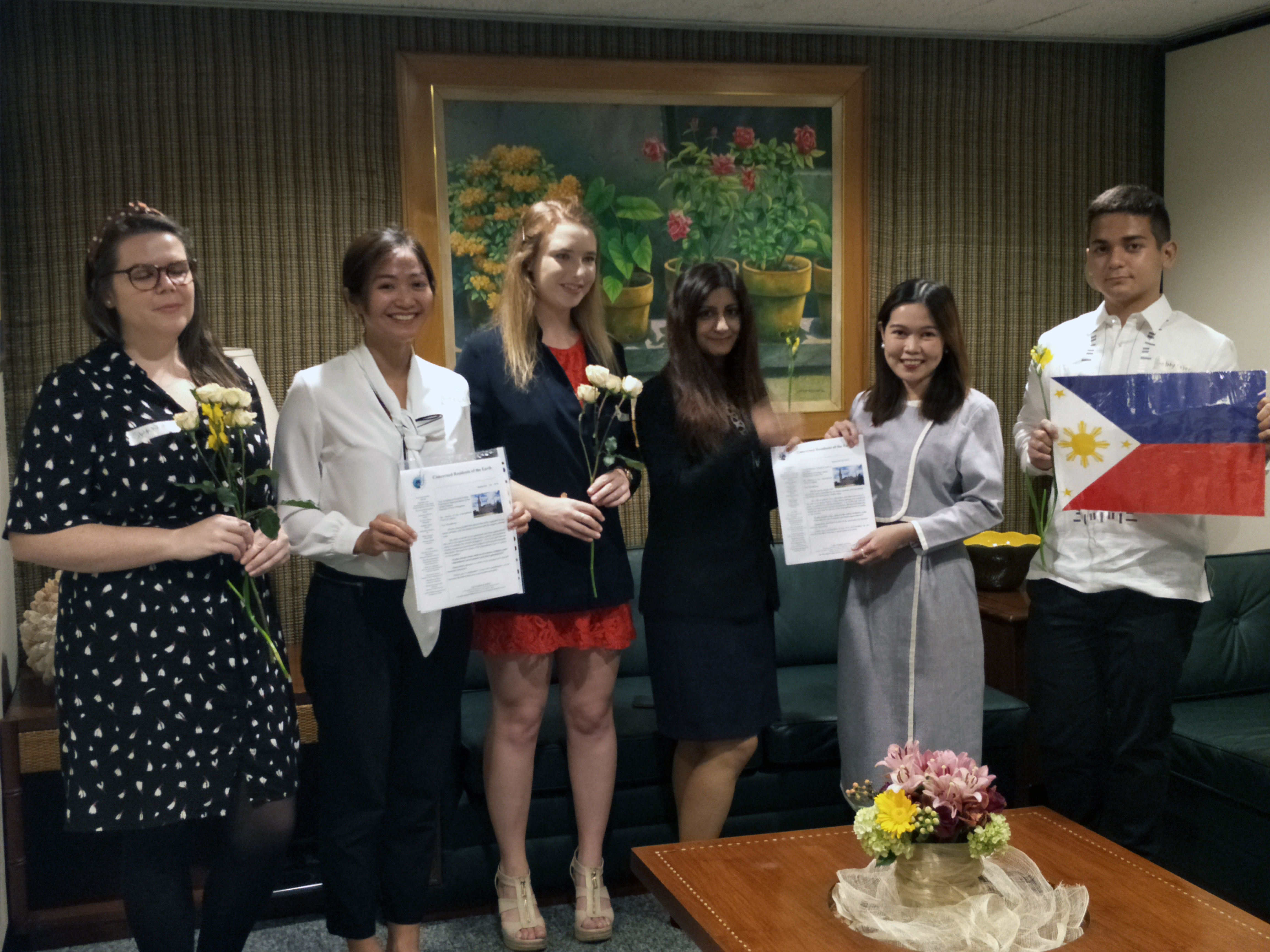
Law students and young lawyers filed a petition to the Philippine Mission to the UN requesting an ICJ advisory opinion on the obligation of states to reduce greenhouse gas emissions, September 24, 2019.
The young are taking action. The voices of the youth are now being heard around the world. That is wonderful. Greta Thunberg and your generation, carry on!
You have the greatest stake in what will happen to the Life-sources of Land, Air, and Waters that will be available in your time. You have all the right to call out our generation’s reckless gambling of your future. We are greedily using and abusing these Life-sources that took all of 4.5 billion years to become what they are. Remember the story of my grandfather?
In a series of bold moves in September 2019, two groups of young people filed legal actions in the UN. On September 23, Greta and company, backed by a crack team of legal eagles, filed a petition to call out the violation of children’s rights. Good job! The day after, September 24, another group of young people–law students and young lawyers from around the world–filed a memorable petition. It was submitted to the Philippine Mission to the UN to request the United Nations General Assembly for the ICJ advisory opinion. A few days later, they filed the same request with the Pacific Island nations of Kiribas and Vanuatu.
Will that petition end up in the UN Missions’ garbage cans? Or will it move through the hallowed hallways of the United Nations and find its way to the International Court of Justice? Que sera, sera. (What will be, will be.) What is important is that these young people have awakened to the dangers of climate change, and are now aware of their powers to take action for a real climate of change. It is also a little piece of play to use the law as a medium in the art of storytelling, and as a tool for global mobilization. And it is a modest but bold attempt to use the law as a matchstick to light the candle of courage and the flame of hope.
In the local arena, a number of legal and metalegal tactics can be used to tell a story and, hopefully, spark action. Dozens of legal actions are now being filed around the world. Among the best known are the Urgenda Foundation case in the Netherlands and Juliana v. United States. Win or lose, the storytelling is both the journey and the joy.
In the Philippines, we are exploring an untried legal approach: to file a petition to perpetuate evidence. We can put on record scientific evidence and prove beyond reasonable doubt that the climate crisis is real, clear, present, and immediate. We can also put on record evidence of what government and people are doing (or not doing) to face the emergency.
Again, the case is not intended to make enemies. We only plan to take down the evidence present today. Using the power of the stationery–the letterhead of a court of law–petitioners can ask questions to their public officials.
If the government officials are doing good, we will nominate them for recognition and commendation by the Normandy Chair for Peace (NCP), by the United Nations, and by the Guardian of Future Generations (GFG).13 We will shine the spotlight on the good, the right, and the bright. This will help continue the good work they are doing beyond the short terms of their offices. Hopefully, it will ensure continuity.
If government officials fail, neglect, or refuse to cooperate, this will be evidence put on record. It can be preserved for future reference in case future generations wish to take action in a court of law.
This is called the candies-and-needles approach in the science and art of legal marketing. Do what is right, and you will receive the candies of congratulations and recognition. If you do not do anything, the evidence will be put on record in a court of law. The sight of a long and sharp needle piercing one’s neck in the future is a sight one does not like to imagine. The threat of pain can often be more painful than the pain itself.
It is time to shift from the harsh energy of enforcement and move to the happy energy of positive reinforcement.
Todo es según el color del cristal con que se mira.
It depends on the color of the lens we use to look (at it).
—Ramón de Campoamor
The story we want. Going back to the title: what is the story? I have tried to tell a few stories. But the real story will be told by you, dear friend, and what you will do after reading these stories.
It is also about how we look at the world. We can look at it through dark lenses and see only the gloom and the doom. Or we can look with bright-colored lenses and see happy energy. It is time to transform today’s doom and gloom and tomorrow’s happy boom and flowery bloom.
NORMANDY CHAIR FOR PEACE
We will have Peace on Earth when we have Peace with the Earth.14
Normandy, once a symbol of war, is now a symbol of peace. On June 5, 2019, a World Peace Forum was held in Normandy, France. It coincided with the seventy-fifth anniversary of the Normandy landings on D-Day, the massive invasion of the Allied forces against the tyranny that then gripped the free world. On that day, June 5, which also happens to be the UN World Environment Day, the visionaries founded the Normandy Chair for Peace. That symbolic chair may well be a beginning of the fusion of two powerful global movements: the peace movement and the environment movement.
After all the bruises of battles and wounds of war, I learned that the best form of law enforcement is when the law does not need to be enforced. That is when people have absorbed the spirit of the law.
Law and science try to change the mind. When you change the mind, it can change tomorrow. But when you change the heart, it is forever. How?
The greatest human hunger is not the hunger for food. It is the hunger of the human heart for approval.
The NCP is but a symbol of peace on Earth–by having peace with Earth. It is a seat on which those of us who believe in this truth are welcome to rest and enjoy. The NCP takes on a new and happy path to send its message to the world. We will cooperate with all those interested to search for the good, the right, and the bright. The Good Stories Movement seeks to tell these stories to inspire and set the hearts of the world on fire.
Ninety-nine point nine percent of what happens in this world is not bad. It is neutral and, in fact, much of it is good. Even in this seemingly dog-eat-dog world, countless acts of kindness and goodness happen every single moment of the day. But why do we hear and read only of the 0.01 percent that is bad news? Because bad news sells?
It is time to change the story! Law and punishments are weak drivers for good conduct. The best drivers are called hope and inspiration. Hope springs eternal, and inspiration is the fuel for the fire of desire.
The seeds of goodness live in the soil of appreciation for goodness.
—The Dalai Lama
We will search for the good stories of people facing and embracing the crisis of climate and of Life on Earth. There are a good number of movements along this line, such as the Equator Prize, Earth Champion, Blue Planet, and many more. They are very selective and prizes are awarded only once a year. Building upon these movements, the Normandy Chair for Peace will try to spread the seeds of goodness by watering them with the appreciation of goodness.
GUARDIAN OF FUTURE GENERATIONS
The International Council of Environmental Law (ICEL), the first international group of lawyers, professors, and jurists focusing on environmental law was founded in 1968. Through its Executive Governor Nick Robinson, this SOB (son of the beach) was recently honored with the title of Guardian of Future Generations.
Synergizing this position with the Normandy Chair for Peace, the Guardian of Future Generations will work toward a change in the MAP of the world: that is, mindset, attitudes, and practices.
The Guardian of Future Generations will invite reports by citizens of good stories and best efforts. There are countless good stories now being written by ordinary people and even by governments to have peace with the Earth.
Recently, I had another awakening. I realized that we must begin to change the story. We can do this by changing the storyline. Together with like-hearted friends, we launched the People’s Gratitude Movement in the Central Philippines in March 2017. This is now evolving into the Good Stories Movement.15
When you criticize,
Speak in secret.
But when you give a kind word,
Shout it to the whole world.
We hope to cooperate with international, regional, national, and local volunteers to search and shine the spotlight on the good, the right, and the bright. The Normandy Chair for Peace and the Guardian for Future Generations will continue to take the following actions:
- We prepare a letter of congratulations and commendation, signed by the NCP, the GFG, and a roster of international luminaries. We send that letter-commendation to the person(s) concerned. Copies will be furnished to their superiors, if any, and to family members, local and national officials, even to the heads of states to which the person belongs. The letter and their work will hopefully find their way to mainstream and social media.
- We hope to hold conferences in the six regions of the world: Latin America, Africa, Europe, Asia, North America, and Oceania. The purpose is to showcase the good stories and share the lessons learned by the people making peace with the Earth. Hopefully it will inspire others and multiply the seeds of growing goodness.
Kind words do not just praise the goodness of others.
Kind words have the power to change
The destiny of the world.
There are ways of making people wake up to the urgency of the climate crisis. First is for them to run out of Water, or die by fire and heat, or drown in floods and storm surges. They must feel the extreme pain and suffering in person and up close. The human population is overdue for pruning. It will come in three general forms: disease, famine, and war. Disease comes with the abuse of nature, such as by eating wild animals or factory farming animals that can transmit disease to humans. The COVID-19 crisis is a good example, and it is showing us now how to be better than we are. Famine follows the loss of fresh Water. And violence will result in the competition for the remaining Life-sources of Land, Air, and Water.16
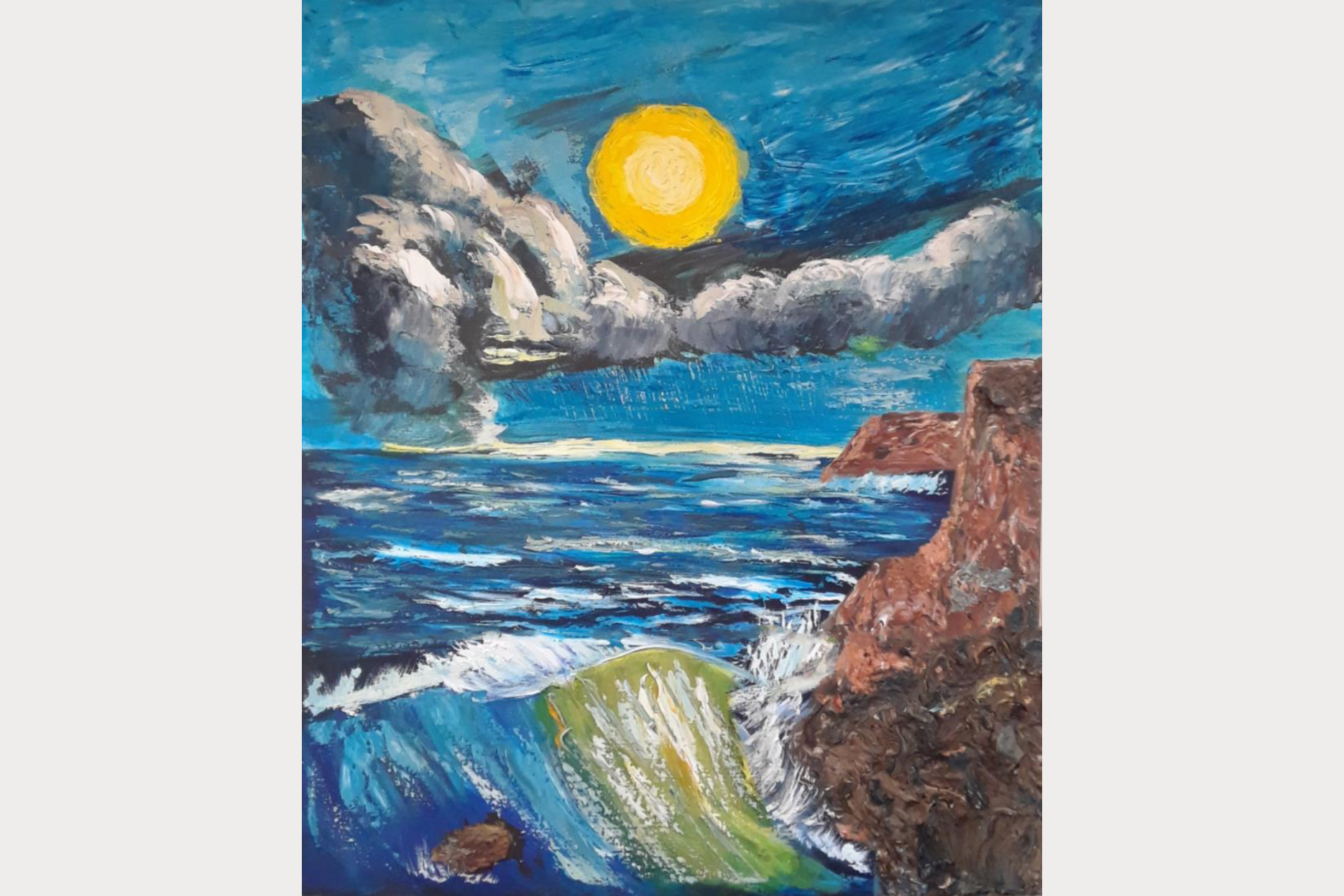
Do we deserve our name, sapiens (wise)? Can we be a force of nature for strong, serious, and sustained action to nourish Life and the Land, Air, and Waters of Life? Can we face with wisdom and courage this chance for a climate of change?
The storytelling will not be done by me, nor by you, nor by them. It will be told by ALL of us: working together, walking together, laughing and loving together in this journey of a dream.
Together, we will walk to the world we want.
